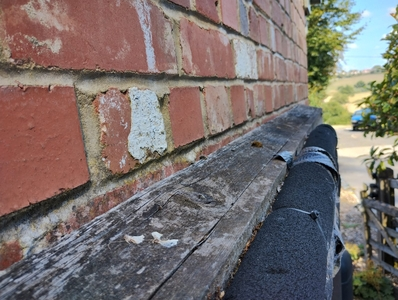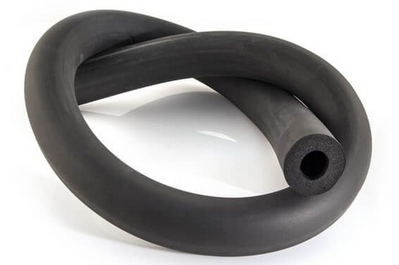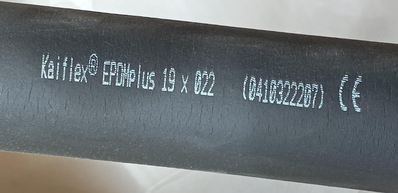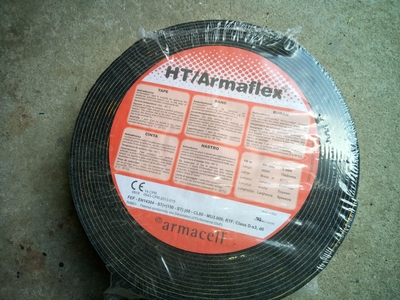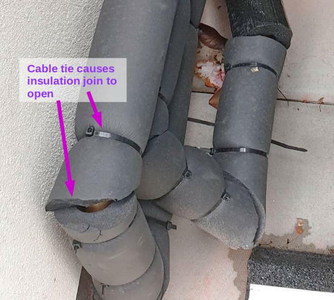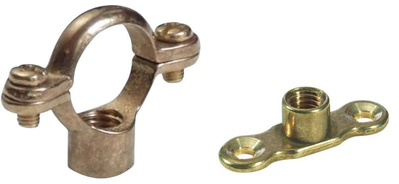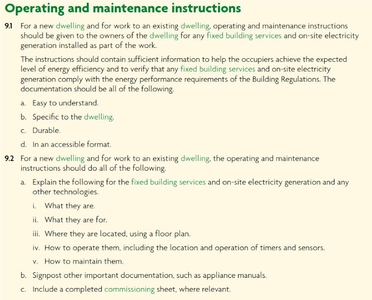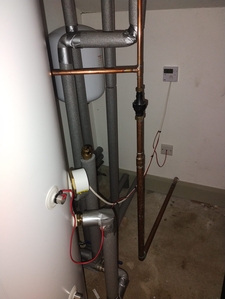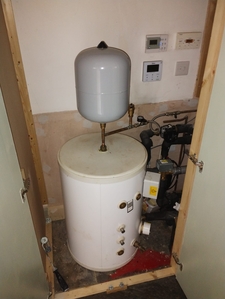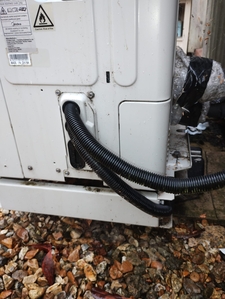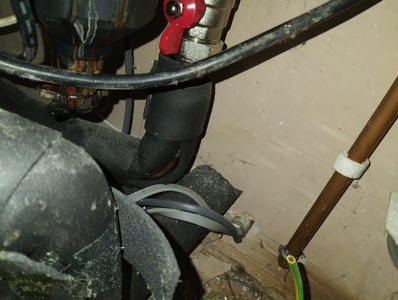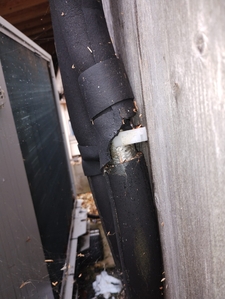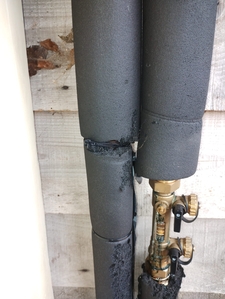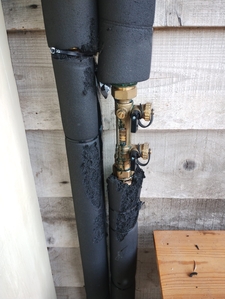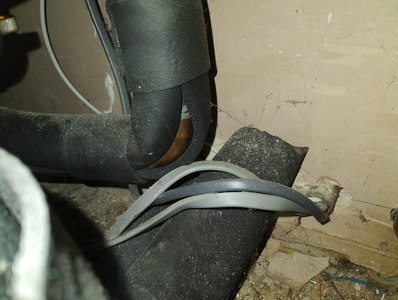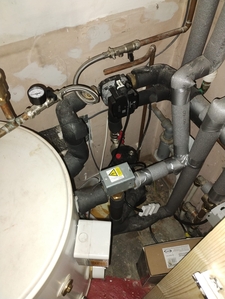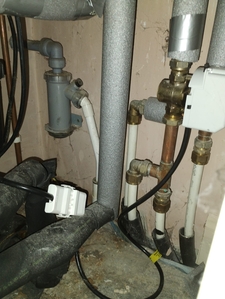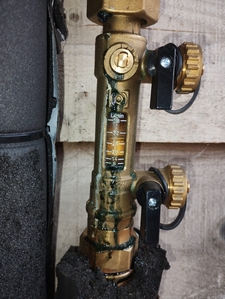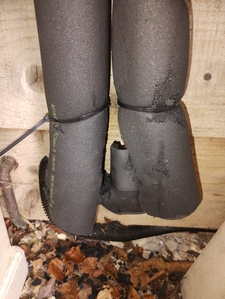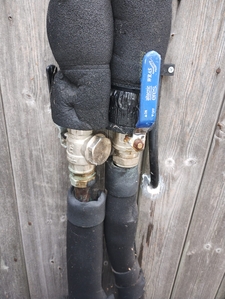@pash44pump - good, we're on the same page (screen) on the wired controller. As you can see from the chart I posted earlier, the LWT/RWT often vary a lot over time, meaning a spot reading doesn't tell us very much. I can't remember whether that hideous Midea app (if you have it - if you don't, don't bother) records and so can chart LWT. If not it is either get out a deck chair and sit by the wired controller for an hour when the heat pump is running, or finding some other way of getting the actual LWT over time.
That is a lot of not well insulated external pipework. Is there any reason why it can't get inside the heated part of the building sooner? I suspect the physical location of the heat pump doesn't help either, but better than in the middle of the lawn I suppose. Nonetheless people do sometimes have very long outside pipework runs. Extra insulation is probably the key thing to get right. @transparent may have some suggestions.
Midea 14kW (for now...) ASHP heating both building and DHW
Fwiw... I set up my weather compensation on LG heat pump... starting with nil base knowledge.
However the initial change was very easy and took less than one hour:
- Changed the controller setting to use the pre-set weather compensation setting
- Changed internal programmer controls so that heating is on 24x7
- Changed internal thermostats to high levels to ensure 24x7 throughput
- Opened all TRVs to max
That basic setup probably achieved 90% of the setup and we could've simply stopped there.
But for best efficiency and comfort further tweaks will typically be required
- Adjust the wc curve slowly (perhaps one degree every few days) by trial and error to get the curve as low as possible.
- Consider using thermostat setbacks overnight but avoid setting back too much (takes a long time to heat back up). Because we're on Intelligent Go with 7p kwh overnight rate we actually INCREASE our target temp overnight which reduces heat demand in the day. Similarly heating hot water to higher temp at night.
Many users of wc recommend avoiding programmers and thermostats completely - which I don't disagree with. Except in my case with batteries and time of use tariff a bit of tweaking with programmer & thermostats works for me - such tweaking is not necessary for many people.
Listed Grade 2 building with large modern extension.
LG Therma V 16kw ASHP
Underfloor heating + Rads
8kw pv solar
3 x 8.2kw GivEnergy batteries
1 x GivEnergy Gen1 hybrid 5.0kw inverter
Manual changeover EPS
MG4 EV
@cathoderay thanks. I've always thought the same - I have no idea why they ran it outside. It can easily go straight into the building and I have someone coming (not original installer) to have a look at costs later this week. I'm not sure if it will be cost effective though - let's wait and see.
Advice from others on what product to use to insulate if it does stay outside would be welcome. At the moment it has gaps at the back and the cable ties cut into the foam making it less effective. I must be losing an amount of heat in very cold weather particularly (which is why I wondered if in/out temps came before pipes i.e. from inside heat pump or post pipes within the house).
@tim441 - an excellent succinct summary.
@pash44pump - re-routing the pipework may well make sense, a one off cost vs a never-ending drip drip drip of heat loss costs into the garden. It will obviously depend on costs. I'm hoping @transparent will chip in with some thoughts sooner or later, what he doesn't know about these things probably isn't worth knowing.
Midea 14kW (for now...) ASHP heating both building and DHW
Posted by: @cathoderaypeople do sometimes have very long outside pipework runs. Extra insulation is probably the key thing to get right.
Thanks for the nudge.
In some places I'm struggling to see any attempt at pipe insulation.
As for the external runs:
This isn't external insulation at all.
There are pits in it which allows ingress of water.
The cells (bubbles) from which it's formed, must be 'closed'.
It should be UV-resistant and have a smooth external surface.
This is often referred to as Solar Insulation.
It first appeared in the days when solar-thermal panels were being roof-mounted.
Have a look at this Kaiflex product, sold by BES
Armaflex is a similar, rival product.
Both companies make a 3mm thick tape which wraps around joins in the lengths of insulation:
All joins should, in any case, be 'welded' with Impact Adhesive applied to both faces of the joint.
Make sure it's touch-dry before pressing the sides together.
Nylon cable ties shouldn't be present on insulation runs.
They compress the wall thickness, leading to cold-spots,
and also cause gaps at bends, which are difficult to glue closed.
To fix an insulated pipe-run in place, use a Munson Ring outside of the insulation.
Most manufacturers have standardised on using M10 threaded (brass) rod between the ring and the base-plate.
It's the diameter of the ring which changes according to the external diameter of the pipe insulation.
There shouldn't be any pipe clips with insulation cut around them!
Insulation needs to extend completely over all valves, whether outside or inside the property.
That's what the larger-diameter insulation sizes are for!
For external runs, check that the larger diameter length is glued to the smaller pipe insulation, preferably by over-lapping it.
There must be no gap for rain to enter between the pipe and its insulation.
That's especially important where the pipes join to the heat-pump itself.
Having rainwater running next to the pipe simply sucks out the heat, and throws it away on the ground below!
Save energy... recycle electrons!
@transparent Wow! Great information. Sounds like it was a terrible installation as far as pipework goes (and probably more). Now I need to find a forum on what to do if your installer did a shoddy job.
Trouble is when I had the system installed (4 years ago) my knowledge was zero and like many people we were relying on the reputation of the installer (which was universal 5* reviews). Only since getting fed up with the system time and time again and finding a forum like this do I have the confidence to tell them where things were at an unacceptable standard.
Thanks all
Posted by: @pash44pumpI need to find a forum on what to do if your installer did a shoddy job.
Irrespective of formal guarantees, you would be protected by the Consumer Rights Act (2015).
Unlike its predecessor, the Sale of Goods Act, it is administered through the Citizens Advice Bureau.
They can not only advise you, but offer mediation or arbitration channels, as appropriate.
They would probably be interested to read this discussion and my point about needing correct insulation.
The reason your installer is "at fault" is predominately because the standard of the work falls short of what's required under Part-L of Building Control.
The system can't be said to "use no more fuel and power than is reasonable in the circumstances" if the insulation
- is of the wrong type
- is improperly installed
- doesn't cover all of the pipework and valves
Building Control is administered by your Local Planning Authority (LPA).
Which Council is it in your case?
If that Council was indeed notified by your installer that he has installed a system which complies,
then they will have sent you a letter to state that.
Such a letter (or certificate) is very important.
In the case of you selling your house, that document would be requested by the purchaser's solicitors.
All Building Control paperwork should therefore be kept with your Deeds.
Your Council should (rightly) be aggrieved that they are being notified by installers to send out documentation for work which doesn't comply.
So this is a subject which should be brought to the attention of your ward Councillor(s).
It doesn't matter whether they understand any of the technicalities of what constitutes a proper/compliant heat-pump installation.
The point is that the Council is being expected to do administrative work which gives false assurances to consumers within its area.
I would hope that the Leader of the Council or its Chief Exec takes up this point with the Local Government Association.
The LGA is in a position where it can write to the Minister for Housing and Local Government, and "require" that the matter is addressed.
And if the Minister fails to resolve the issue, then it should be brought to the attention of the Select Committee on Housing, Communities and Local Government.
That's a cross-party committee, whose members can hold the Minister's feet to the fire.
That's how democracy is meant to work.
Please make sure that your Councillors have the URL of this Topic, and can read the explanations I've just given.
Thanks.
Save energy... recycle electrons!
@pash44pump lots of good advice from others on tests, operation modes, insulation and rights which would confuse matters if I comment on separately.
It might help you think about it if I set our the things we are trying to discover by experiment (ideally at somewhere near design OAT = -1 I believe):
- What temperature do the pipes in the UFH need to be at to satisfy the demand (hopefully 35C or less), assuming the rads are on and heating the upstairs and the UFH is fed constantly with water at that temperature, and everything is operating 24*7
- What temperature do the rads need to be at to satisfy the demand (hopefully 45C or less), assuming the UFH is on and heating the downstairs and the rads are fed constantly with water at that temperature, and everything is operating 24*7
- What temperature is being lost between heat pump and rads/UFH either (a) in pipework or (b) across the buffer?
- What is the deltaT flow to return in the rads and the UFH
- Given that there are 2 control systems (one for the ASHP and one for the UFH), which are almost certainly completely separate , is there something in the way that they interact that is stopping water at the necessary temperature reaching the emitters 24*7 (*)
Turning thermostats up to max explores 1 & 2 (essentially what both @cathoderay and I suggest as a good start) and turning mixing valves to max in addition explores (5) and gives some more info. To determine (3) and (4) we need to measure some temperatures at convenient measurement points that are likely to represent the temperatures of interest.
Once we are clear about some of this (we may not need it all) we should be in a position to work out where the bottleneck is that is stopping the heat generated by the heat pump getting to the emitters, or causing the heat pump to generate less heat than the emitters need. The various things I and others have suggested explore this space.
Maybe that explanation helps, if it doesn't then feel free to ignore.
If you still want me to answer any specific questions you have asked above please ask once more by posting again.
(*) in the same way as (very probably) its the interaction (or in this case lack of interaction) between the disconnected control systems that is causing your summer quirk
4kW peak of solar PV since 2011; EV and a 1930s house which has been partially renovated to improve its efficiency. 7kW Vaillant heat pump.
@jamespa thanks. I will follow up on that shortly.
I have been reading various parts of this website including "the good, the bad and the not so great".
I am better informed but concerned that my installation may be substandard. It's certainly true (and I have known this and raised it with the installer a number of times) that the external pipework installation is of an unacceptable level (thanks @transparent). Before I go back to the installer, I would like to try and understand if there are any other issues that don't meet the necessary standards as well as understand exactly what I have in my system.
So, I have taken more photos of the various parts of the system and I have managed to get the installers to resend my planning and scope documentation which gives more detail about how the system was designed and I will post that seperately.
Let me know if there are any other photos you require to assess the overall system and its appropriateness as a design and installation. I'm hoping I'm not going to be another test case of "how not to" on this site.
Many thanks
This is the scope document for my system to follow up on the heat loss pages I posted earlier in the thread. Thanks
@pash44pump - thanks for the photos and 'scope' document. Both the installation and the 'scope' document appear somewhat chaotic, and, so far as I can see, there is still no formal heat loss survey/calculation. There is a remark that the building is 'very well insulated' but that is not a heat loss survey and more to the point I get the impression it is a very large property, whether it is well insulated or not.
There is a lot to digest and consider. One useful thing I note is that you have an analogue flow meter in the primary circuit. Rather crude, but a useful way of confirming what the wired controller reports. But the stand out thing for me is that in the 'scope' document there is a line that says "Flow/Return Pipe Thickness 22" and if that is the case ie the primary flow and return pipework is 22mm (I can't really decide from looking at the photos) then you have a number one candidate for system insufficiency. Can you please measure the outside diameter of the primary pipework and post it here?
I also note the 'scope' document mentions a 12kW Media (sic) R32 Unit. Tempted as I am to ask whether it is programmed to receive, can you please confirm what you actually have, as I think I recall you said the actual unit is 16kW. Note this is more about matching the actual installation to the scope document at this stage, not what size you actually need (which needs a proper heat loss calculation). Furthermore, as I mentioned earlier, the 12, 14 and 16kW models are the same hardware, output is set in software using dip switches.
Finally, can I suggest you specifically ask you installer for a copy of their formal heat loss calculation? If they provide one, we can have a look at it, if they don't have one, then things just might get a whole lot more interesting.
Midea 14kW (for now...) ASHP heating both building and DHW
@cathoderay thank you. External pipework is 90mm and the Midea is 12kW (my prior typo). I will ask installer for heat loss calculation now.
- 26 Forums
- 2,364 Topics
- 53.6 K Posts
- 88 Online
- 6,029 Members
Join Us!
Worth Watching
Latest Posts
-
-
RE: Octopus Cosy Heat Pump Owners & Discussion Thread
@kevh it's worth remembering that many lsvs only actual...
By JamesPa , 8 hours ago
-

@majordennisbloodnok Education, Education, Education…
By Toodles , 11 hours ago
-

RE: Setback savings - fact or fiction?
Exactly. We only need to compare conditions, to decide ...
By cathodeRay , 14 hours ago
-
RE: Balancing financial efficiency and comfort using the Octopus Cosy tariff
I found because I have very low heat loss I can set bac...
By RadWhisperer , 17 hours ago
-
RE: Need Help Optimising My Rushed ECO4 Install: 12kW Bosch Heat Pump
Welcome @mickamills We too have an oversized 12kW Sa...
By Old_Scientist , 23 hours ago
-
RE: My Powerwall 3 Consumes 3-4 kWh/Day in Self-Consumption: Is This Normal?
@caron I can confirm that the power usage of the PW3 is...
By Old_Scientist , 23 hours ago
-
RE: Speedcomfort radiator fans
Thats true, but having tried (and succeeded) in constru...
By JamesPa , 1 day ago
-
RE: Solis S6-EH1P8K-L-PLUS – Why I Chose It and What I’ve Learned So Far
@bash brilliant, thanks for the feedback
By energy9165 , 1 day ago
-

RE: Heat Pump Heats the House… But It’s Not Cosy. Emitter Changes or System Tweak?
@alastair There I was, feeling grumpy, he said “Cheer u...
By Toodles , 1 day ago
-
RE: Grant Aerona: Is there a setting to keep the 2-port valve open during pump blockade
Depends on OAT. Mine cycles at OAT>10 and of course...
By JamesPa , 1 day ago
-
RE: New Fogstar 15.5kWh upright solution
@transparent My conclusion is as you have noted, tha...
By Bash , 1 day ago
-
RE: Mitsubishi Ecodan R290 10kW performance
And to you too. Wishing you a very enjoyable festive s...
By Sheriff Fatman , 1 day ago
-

RE: External pipework insulation
They do? But that isn't apparent from the photos we'r...
By Transparent , 2 days ago
-

RE: Say hello and introduce yourself
@velcro welcome to the forums. Please feel free start a...
By Mars , 2 days ago
-
Daikin EDLA11D3V3 DHW Settings
I have a newly installed EDLA11D3V3 which I'm still get...
By Velcro , 2 days ago
-
RE: Midea ASHP – how to set weather compensation
@curlykatie did you get sorted with this?
By MickaMills , 2 days ago
-
RE: MyVaillant Connect Regular Disconnect
Thanks. Yes, if the time is consistently 11pm every nig...
By buckwem , 3 days ago


